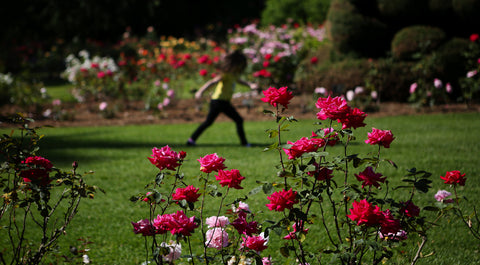In the Garden
Fragrance is often sacrificed by breeders seeking to create disease-free roses. But Kordes roses, in addition to high marks for being disease resistant, also produce beautiful fragrance and colors.
Breeders of disease-free roses often sacrifice fragrance in order to achieve disease resistance. While researching roses for her new book to be released later this year, Nita Jo Rountree discovered a line of roses that offer both fragrance and disease resistance that are becoming available at a few select nurseries in our area.
The breeders of Kordes roses list disease resistance as their top priority; however, they also strive to introduce roses with complicated flower shapes, unique colors, repeat blooming and fragrance. Among Rountree’s recommendations is ‘Grande Amore’, a hybrid tea featuring bright, red petals and dark, glossy foliage. It was awarded “Best Hybrid Tea” of Portland’s Best Roses 2013.
Another gem is ‘South Africa’. This grandiflora combines enticing fragrance with gorgeous, dark, copper-gold flowers on a vigorous shrub. ‘Poseidon’, a floribunda with unusual color, is a prolific bloomer producing double, classic, cup-shaped flowers of pure lavender.
If you’re looking for a disease-resistant climber to cover a low fence or small arbor, consider ‘Honeymoon’. It blossoms practically nonstop all summer, with creamy clusters. If you like classic hybrid tea roses and love fragrance, save a prized spot for ‘Beverly’. It features huge, vivid pink, multi-petaled flowers that are so fragrant, visitors have been known to faint when they smell the blossoms.
Don’t prune the tweedle out of your new tree
February is a great time to plant a tree or shrub. Nurseries have a wide selection of both bare-root and potted plants. Planting them in late winter gives the plant time to develop a strong root system before the heat of summer.
When you plant your new tree or shrub, resist the urge to prune the living tweedle out of it. Generally speaking, any tree or shrub you buy at the nursery has already been pruned, and the worst thing you can do is lop off the end of every branch.
Tip pruning, as the process is called, will stimulate a great deal of branching and side growth, diverting energy needed for strong root growth. Only prune your newly planted tree to promote a sturdy, attractive branching structure.
If your tree has co-dominant leaders (two similarly sized branches growing straight up from the same point in the tree) remove the weakest one. If left in place, one or both of the co-dominant branches could break off in a future ice or wind storm.
Next, remove branches that are growing into and crowding the center of the tree. At the same time, remove smaller branches crossing over larger ones to prevent them from rubbing and causing wounds in the bark after the branches grow larger.
Wait to tip prune until the second season, but only if side branching hasn’t begun to occur. By the way, if you’re planting a fruit tree, you should remove any fruit that forms during the first season as soon as it appears, or it will steal energy needed to establish a healthy root system. OK, you can let a few of them ripen on the tree. It’s just too painful to remove every one of those delicious fruits.
Ciscoe Morris: ciscoe@ciscoe.com. “Gardening With Ciscoe” airs weekly on KING 5; check local listings.

